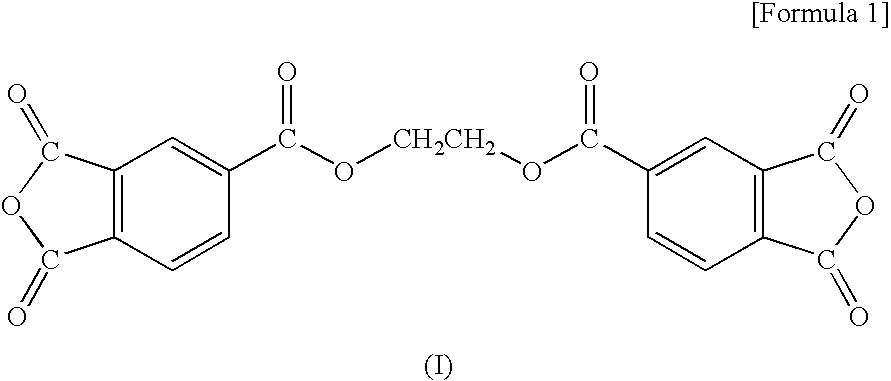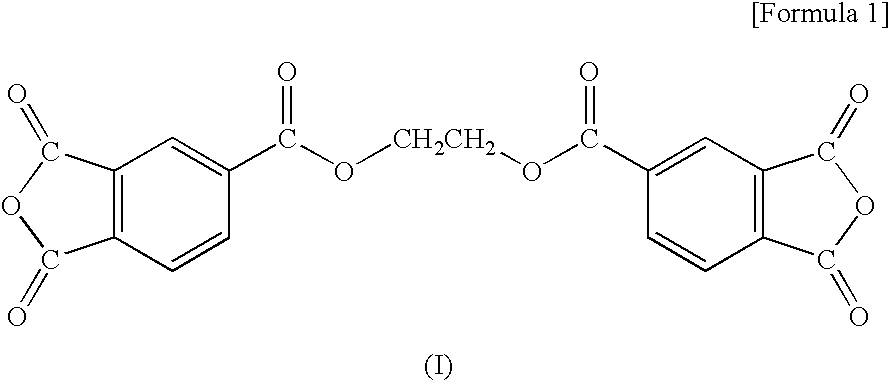Adhesive and laminate for packaging using the same
a technology of adhesives and laminates, applied in the field of urethane-based adhesives, can solve the problems of deterioration in heat resistance and prohibiting the preservation of adhesiveness during long-term storag
- Summary
- Abstract
- Description
- Claims
- Application Information
AI Technical Summary
Benefits of technology
Problems solved by technology
Method used
Image
Examples
example 1
Preparative Example 1
Preparation of Partially Acid-Modified Polyester Alcohol (A-1)
[0089]In a four-necked flask, placed were 20.5 parts of ethylene glycol, 45.8 parts of neopentylglycol, 38.9 parts of 1,6-hexanediol, 61.4 parts of isophthalic acid, 61.4 parts of terephthalic acid, 50.5 parts of sebacic acid and 1.2 parts of benzoic acid. The mixture was heated to 240 degrees C. while stirred under nitrogen stream for dehydration condensation, and the reaction was continued so that the acid value was reduced to 5 or less. Gradually decreasing the pressure to 1 mmHg, the reaction was further continued at that pressure for vaporization of excess alcohol, to give a polyester alcohol (Aaa-1) having a hydroxyl value of approximately 9 mgKOH / g and a number-average molecular weight of approximately 11000.
[0090]Stirring 300 g of the polyester alcohol (Aaa-1) under nitrogen stream, it was heated and 3 g of isophorone diisocyanate was added thereto in an atmosphere at 150 degrees C., and stirr...
example 2
Preparative Example 2
[0092]A partially acid-modified polyester alcohol (A-2) was obtained in the same manner as Preparative Example 1, except that the urethane modification was not performed.
examples 3 to 11
Preparative Examples 3 to 11
[0093]Partially acid-modified polyester alcohols (A-3) to (A-11) were obtained in the same manner as Preparative Example 1, except that the blending ratio of the raw materials used was changed respectively to the composition shown in Table 1 (values in Table: part by mass).
[0094]The average number of hydroxyl groups in the molecule of each of the polyester alcohols (Aaa-1 to 11), the urethane-modified polyester alcohols (Aa-1 to 11) and the partially acid-modified polyester alcohols (A1 to 11) was calculated from the number-average molecular weight and the hydroxyl value experimentally determined. Results are summarized in Table 1. From these values, it is possible to calculate the number of blocked end groups esterified to the monofunctional component, the number of urethane-modified end groups, and the average number of the acid-modified end groups in the molecule of each of the partially acid-modified polyester alcohols (A1 to 11). Each of partially ac...
PUM
| Property | Measurement | Unit |
|---|---|---|
| hydroxyl value | aaaaa | aaaaa |
| hydroxyl value | aaaaa | aaaaa |
| hydroxyl value | aaaaa | aaaaa |
Abstract
Description
Claims
Application Information
 Login to View More
Login to View More - R&D
- Intellectual Property
- Life Sciences
- Materials
- Tech Scout
- Unparalleled Data Quality
- Higher Quality Content
- 60% Fewer Hallucinations
Browse by: Latest US Patents, China's latest patents, Technical Efficacy Thesaurus, Application Domain, Technology Topic, Popular Technical Reports.
© 2025 PatSnap. All rights reserved.Legal|Privacy policy|Modern Slavery Act Transparency Statement|Sitemap|About US| Contact US: help@patsnap.com



